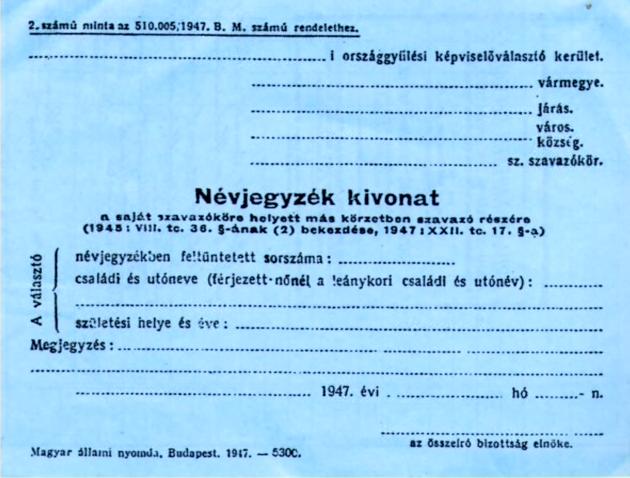We remember the worst fraud of the last century, the blue-label elections. Written by Károly Szerencsés.
"Even Tutu hangs his nose, he didn't expect that either," noted Dezső Futó, the excellent national democratic politician, somewhat sarcastically, when the first results of the election arrived on the night of August 31, 1947.
Gyula Ortutay, flirting with the winger, reacted to the shocking defeat of the Independent Small Farmers' Party. The FKGP dropped from fifty-seven percent in 1945 to below fifteen percent. Mátyás Rákosi, on the other hand, seemed satisfied: "I was convinced that we would rise above 25 percent," he declared. And really! They tribbled - played tricks - until twenty-five percent came out in the end. In fact!
But let's start from the beginning. In the spring of 1947, it seemed that Hungary's sovereignty would be legally restored. The Paris Peace Treaty was signed, which included the end of the occupation. We got worse borders than in Trianon, we had to deliver a huge amount of "reparation" goods to the Soviet Union, Yugoslavia and Czechoslovakia, but legally sovereignty was (would be) restored. The peace treaty did include that Soviet troops could remain in Hungary, but only to secure the supply lines to Austria. Most people believed that the Austrian question would be resolved soon. In Moscow and in the general staff of the Hungarian Communist Party, they believed that it would be dangerous if sovereignty were restored and a significant bourgeois-national-Christian-democratic majority remained in the Hungarian parliament. In addition, there were also the social democrats, whom Stalin and Rákosi did not trust for a moment, they were also considered enemies. The 17 percent communist faction – supplemented by some crypto-communists – represented a slim chance for the Rákosi.
That is why they decided that the quasi-democratically elected National Assembly in 1945 should be liquidated even before sovereignty was restored. They created the prerequisites for this: a "huge fascist anti-republican conspiracy" at the ÁVÓ and the People's Court, in which the leaders of the small farmers' party and the prime minister himself were implicated.
The political police (ÁVO and KATPOL) covered by the occupiers, on which the government had essentially no influence, increased the terrorization of the nation. Constant demonstrations, fights and chaos characterized the public situation, the opposition press was silenced, the Hungarian Freedom Party was liquidated - branded as far-right - and finally the far left achieved the dissolution of the National Assembly. Otherwise, his mandate would have lasted until November 1949. From Moscow's point of view, all of this coincided with the beginning of the Cold War, since with the announcement of the Truman Principle, the United States and the Soviet Union, allies in the Second World War, turned fatally against each other. So Moscow wanted to eliminate the "disorder" in Hungary, which it considered its own territory, that the Hungarian electorate only voted less than seventeen percent for the communists. But where was the guarantee that the results that Moscow liked would be born in the new elections? In the performance and program of Rákosi's communists? Hardly, and they were aware of this even in Moscow.
Therefore, they gave their fifth column a free hand to use all possible means to achieve an absolute majority of the (Far) Left Bloc in the parliament. Therefore, they "sieved" the list of names and unlawfully excluded (or "forgot") 10-12 percent of voters. Who was excluded? Those who could be assumed not to vote for the "left". A typical example: the district administrator, Comrade Herceg , "precisely evaluates the streets assigned to him, e.g. he characterizes his parents as follows: his father is a small farmer, his mother is an enemy, he is under the influence of clerical reaction." The new type of man!
In addition, the new opposition parties had to obtain a large number of written recommendations, and a premium system was introduced, which rewarded the electoral coalition of the governing parties with mandates in case of certain results. What made this election famous, after all, was the "blue card", that is, a register extract that allowed its owner to vote anywhere in the country. This was issued by the competent Election Commission of your place of residence. It wouldn't have been a problem if the communists didn't have the idea (some suggestion) that they should "live with" this tool. In other words, fake blue cards must be printed in large numbers and thus fake votes must be cast, so that the result is definitely favorable, that is, the (Wide) Left Bloc definitely wins an absolute majority.
They calculated that this would require a minimum of fifty thousand and a maximum of three hundred thousand fake votes. The predictions were fairly accurate for the Communist Party; on the other hand, all the other parties were thoroughly ignored.
The communists prepared a precise plan, according to which twelve thousand people had to cast 208 thousand false votes. An activist has an average of seventeen. This required reliable people, trucks, accurately filled out and stamped fake name certificates. A certain degree of initiation by the police was also necessary. This was supervised by László Rajk, Minister of the Interior. Of course, Gábor Péter, head of the ÁVO, and police chief Ferenc Münnich were also inaugurated. What names! Let's quote from an invitation: "We are asking for fifty good comrades from Csepel to Zemplén on the 31st. Their presence here ensures the party's electoral victory. I want one hundred percent bolsies. They will vote in about twenty places. The cars should be unadorned and quiet."
In the end, they decided - to divert the inevitable scandal - to include the Social Democrats in the action, of course only to a minimal extent. Through György Marosán, the party was offered a few tens of thousands of fake blue cards. Marosán said: "I certainly knew what cards the communists were playing. I knew they would have no regard for anyone or anything. I sat down to negotiate in a friendly manner, sixty thousand is theirs, sixty thousand is ours."
However, on the day before the election, printers reported to the Social Democratic Center that they were printing many more fake blue slips. Therefore, the leadership of the party "stepped back" and expected the communists to do the same. However, they continued the fraud, which was so large-scale and so oblivious to the conspiracy that on the morning of August 31, it swelled into a national scandal.
The social democrats protested the loudest, Justice Minister István Ries threatened to resign. A government crisis was on the horizon. Everyone protested: the opposition parties, the United States, Cardinal Mindszenty, but to no avail. The promises and intimidation made the social democrats back down, the collaborating small farmers assisted in the liquidation of Hungarian democracy in exchange for a few velvet chairs. But for this, one more step had to be taken, because despite all the fraud and abuse, the (Far) Left Bloc did not get the absolute majority. In fact!
The premium system did not come into effect either, because the government coalition did not even reach the sixty percent threshold. For this reason, the Ministry of the Interior simply transcribed fifty-four thousand votes for the small farmers, and thus exceeded the desired threshold by 44,985 votes, which meant that the Communist Party, for example, obtained twenty-five percent of the mandates with twenty-two percent of the votes, and the small farmer party was also raised above 16 percent. But the Left Bloc did not win an absolute majority. That is why the Rákosi's - with the help of social democrats, peasants, small farmers and radicals - attacked the mandates of the Hungarian Independence Party and, taking advantage of their dominance in public life and in court, destroyed them.
There were forty-nine mandates (14 percent), so the communists and their collaborators could easily eliminate parliamentarism and the remnants of democracy. József Révai put it this way: the "disorder that only seventeen percent of the voters sided with us" . Of course, this did not mean that significantly more people voted for them, only that "other tools" were used. It would be good to pay attention to these even today, and by no means only in Hungary!
Featured image: Blue label! The communist iron fist/Source Wikipedia













